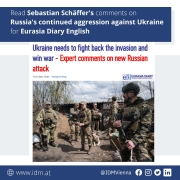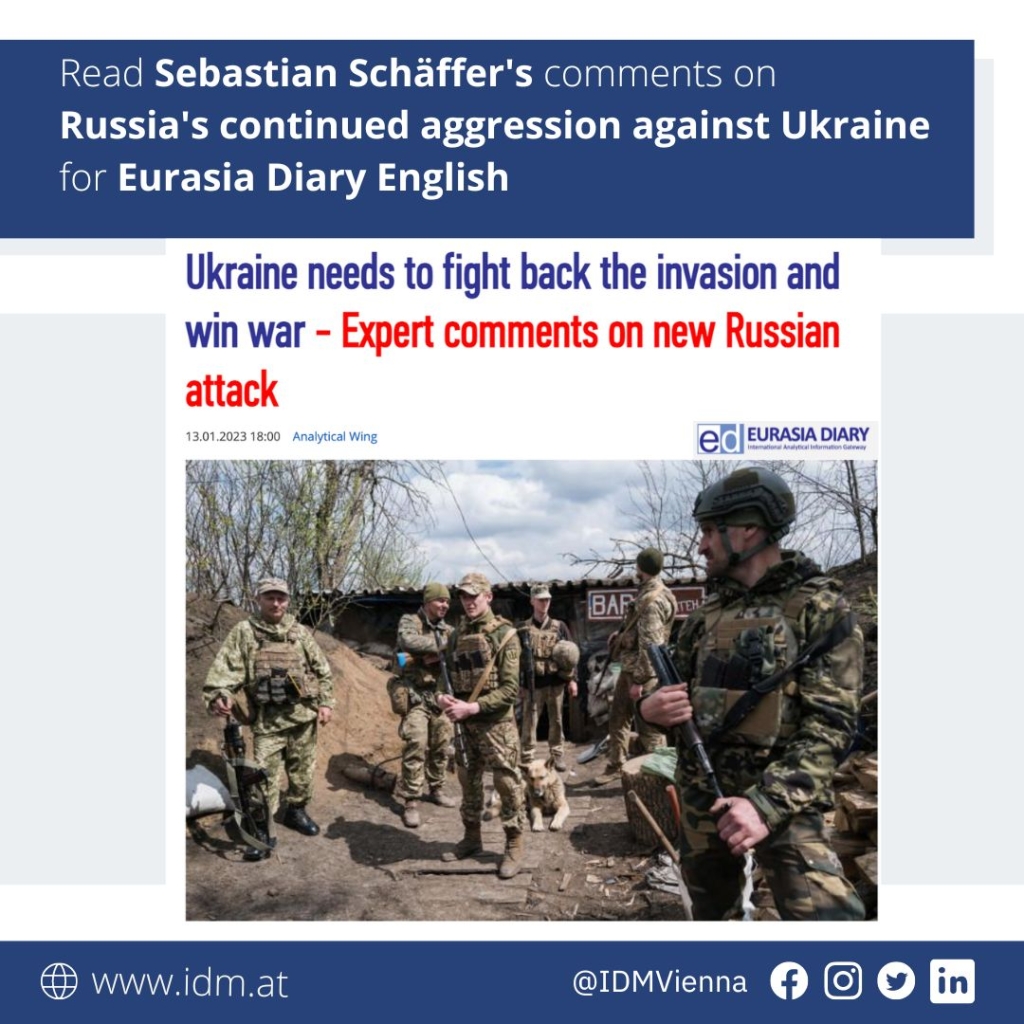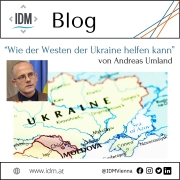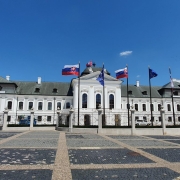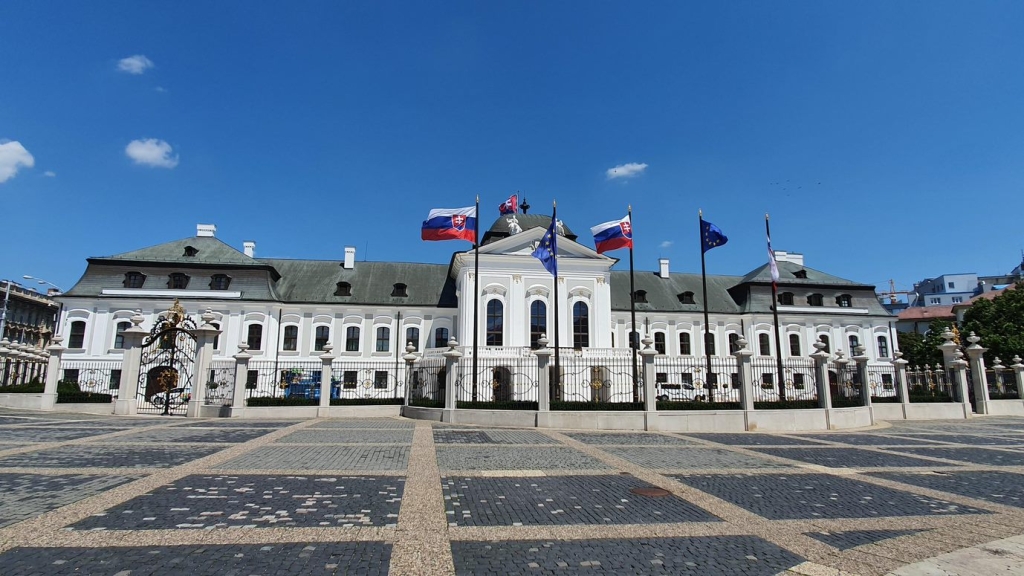
Andreas Umland
Wie der Westen der Ukraine helfen kann
Drei Strategien für einen ukrainischen Sieg und Wiederaufstieg
(Ein Projekt des Stockholmer Zentrums für Osteuropastudien des Schwedischen Instituts für Internationale Angelegenheiten.)
Zusammenfassung
Angesichts der geopolitischen Bedeutung des russisch-ukrainischen Krieges und des noch weit entfernten Beitritts der Ukraine zur EU und NATO sollten die derzeitigen westlichen Ansätze, Strategien und Maßnahmen intensiviert, modifiziert und erneuert werden. Während einige bestehende Programme verstärkt und angepasst werden können, werden auch neue Instrumente benötigt. Sie sollten mit einer besseren Erläuterung der Beweggründe für langfristige westliche Hilfe für die Ukraine einhergehen. Bei dieser Unterstützung geht es (a) um die nationalen Interessen westlicher Staaten und nicht nur um internationale Solidarität, (b) darum, nicht nur den Krieg, sondern auch den Frieden danach zu gewinnen und (c) die Ukraine zu erneuern, anstatt sie nur wieder aufzubauen. Vorrangige Bereiche für Unterstützung sind die Verteidigungs-, Sicherheits-, Verkehrs-, Kommunikations- und Energieinfrastruktur der Ukraine. Der Neuaufbau sollte eng mit dem schrittweisen EU-Beitritt der Ukraine sowie mit weiterer Dezentralisierung verknüpft werden. Mehr direkte Kontakte zwischen ukrainischen und westlichen Kommunen, Organisationen und Unternehmen können durch vereinfachte Aufenthaltsregeln für EU-Bürger und andere Bürger aus befreundeten Staaten, eine politische Risikoversicherung für ausländische Investoren und Handelspartner der Ukraine sowie ähnliche Maßnahmen gefördert werden. Zentrale Voraussetzung für westliche Hilfe ist, dass Kyjiw seine Rechtsstaatlichkeit und Korruptionsbekämpfung stärkt. Auch nach dem gegenwärtigen Krieg wird eine Rüstung des ukrainischen Frontstaates unumgänglich bleiben – vor dem Beitritt des Landes zur NATO und darüber hinaus.
Einführung
Während der letzten Monate wurden zahlreiche Berichte und Kommentare veröffentlicht, die sich mit Aspekten des ukrainischen Widerstands gegen Russland sowie den Aussichten eines Wiederaufbaus und einer europäischen Integration der Ukraine befassen (siehe unten). In diesen Papieren wurden verschiedene Wege und Instrumente aufgezeigt, mit denen der Westen die Ukraine bei ihrer Verteidigung und Neugeburt unterstützen kann. Der vorliegende Bericht fasst einige dieser Vorschläge zusammen und klassifiziert die Instrumente zur Unterstützung der Ukraine, sowohl im militärischen als auch im zivilen Bereich, nach der Notwendigkeit, sie zu beschleunigen, anzupassen oder neu einzuführen. Solche Änderungen, Anpassungen und Neuerungen gelten in unterschiedlichem Maße für verschiedene Arten westlicher Unterstützung für die Ukraine, d. h. die für militärische und Nothilfe, makrofinanzielle, humanitäre und technische Unterstützung, Modernisierung sowie europäische Integration des Landes. Mehrere der nachstehenden Vorschläge sind auch auf Moldau und Georgien anwendbar, die sich in eingefrorenen Konflikten mit Russland befinden und in der Zukunft ein ähnliches Schicksal erleiden könnten wie die Ukraine.
Dieser Bericht konzentriert sich auf einige zentrale Herausforderungen, die häufig bereits in früheren Veröffentlichungen erörtert wurden. Eine Reihe anderer relevanter Themen, wie z. B. Moskaus künftige Reparationen, Chinas derzeitiges Verhalten, das Lubliner Dreieck oder das Quadriga-Format sowie die besondere Rolle ausgewählter Nationalstaaten als Unterstützer der Ukraine, werden aus Platzgründen ausgelassen. Im zweiten Teil werden einige spezifische Herausforderungen bei der Umsetzung verschiedener intensivierender, modifizierender und innovativer Maßnahmen untersucht. Der Bericht schließt mit sechs politischen Empfehlungen und einem Hinweis auf die langfristige strategische Dimension weiterer Aufrüstung der Ukraine.
Drei Unterstützungsstrategien: Intensivierung, Modifizierung, Innovation
Strategie 1: Intensivierung
Der einfachste Ansatz, die Ukraine schnell zu unterstützen, ist eine schnellere und gründlichere Nutzung bereits bestehender Verträge, Programme und Formate, die in ihrer derzeitigen Form geeignet sind, die Resilienz des Landes zu erhöhen. Dies bedeutet eine Beschleunigung oder Ausweitung u.a. der:
- Zusammenarbeit der NATO mit der Ukraine im Rahmen des Enhanced Opportunity Program (EOP), der NATO-Ukraine-Kommission (NUC), des Comprehensive Assistance Package (CAP), der Plattform zur Bekämpfung hybrider Kriegführung, der Gemeinsamen Arbeitsgruppe für technische Zusammenarbeit im Verteidigungsbereich usw.
- Koordination der Waffenlieferungen innerhalb der so genannten Ukraine Defense Consultative Group („Rammstein-Gruppe“) zwischen 50 Ländern, die Kyjiw militärisch unterstützen,
- Umsetzung des Assoziierungsabkommens (AA) zwischen der EU und der Ukraine sowie der vertieften und umfassenden Freihandelszone (DCFTA), der Zusammenarbeit in der EU-Energiegemeinschaft, usw.,
- Einbeziehung der Budget- und Wiederaufbauhilfe für Kyjiw in die Finanzplanung der EU und ihrer Mitgliedsländer, bis die Ukraine wieder finanziell selbständig ist,
- Beteiligung der Ukraine am Green Deal der EU, um nicht nur Umweltziele, sondern auch nachhaltigere Energieeffizienz und tiefere europäische Integration zu erreichen, und
- Tätigkeit von internationalen Strukturen, an denen die Ukraine beteiligt ist, wie den Vereinten Nationen und Unterorganisationen, internationalen Finanzinstitutionen, dem Europarat, der OSZE und anderen.
So ist beispielsweise das Assoziierungsabkommen zwischen der Ukraine und der EU auch ohne Änderungen ein wirksames Instrument zur Unterstützung und Integration der Ukraine. Das Assoziierungsabkommen geht über die Europa-Abkommen der ostmitteleuropäischen Staaten aus den 1990er Jahren und die 2001-2015 unterzeichneten Stabilisierungs- und Assoziierungsabkommen mit den westlichen Balkanstaaten hinaus. Während die letztgenannten Verträge von Anfang an eine EU-Beitrittsperspektive beinhalteten, enthielt das Assoziierungsabkommen der Ukraine von 2014 eine solche Zusage nicht. Erst im Juni 2022 folgte der EU-Kandidatenstatus. Dennoch sind die Assoziierungsabkommen der Ukraine, Georgien und Moldawien bereits seit 2014 umfassendere und wirksamere Europäisierungsinstrumente als die älteren Assoziierungsabkommen der EWG/EU.
Die neuen Assoziierungsabkommen des Ostpartnerschaftsländer sind als solche in der Lage, das Assoziationstrio tief in den Europäischen Wirtschaftsraum zu integrieren und die drei Länder auf den Beitritt zur Union vorzubereiten. Die EU, ihre Mitgliedstaaten und Kyjiw sollten daher die Umsetzung des Assoziierungsabkommens sowie anderer bereits bestehender Kooperations- und Integrationsprogramme so weit wie möglich beschleunigen. Die bloße Intensivierung der bereits bestehenden Zusammenarbeit als relativ unkomplizierter Weg, der Ukraine zu helfen, wird jedoch nicht ausreichen, um den grundsätzlich neuen Herausforderungen und Bedrohungen Osteuropas gerecht zu werden.
Strategie 2: Modifizierung
Diese Strategie bedeutet eine Anpassung, Überarbeitung oder Neuformulierung bereits bestehender, aber veralteter Algorithmen, Programme oder Politiken, um sie für die Ukraine unter den radikal veränderten Bedingungen nach dem 24. Februar 2022 geeignet zu machen. Dies könnte unter anderem bedeuten eine:
- Ausweitung des derzeitigen westlichen Sanktionsregimes, so dass es einen größeren Kreis privater und kollektiver Systemakteure innerhalb Russlands sowie ein breiteres Spektrum nicht-russischer Unternehmen trifft, die Moskau mit kriegsrelevanten und anderen kritischen Technologien oder Dienstleistungen versorgen,
- Einführung eines gestaffelten EU-Beitrittsverfahrens für das Assoziationstrio, d. h. die schrittweise Einbeziehung der drei Länder in verschiedene Unterorganisationen, Leitungsorgane, Regelwerke, Branchenabkommen und Sonderprogramme der EU bevor das Trio die Vollmitgliedschaft erlangt,
- Ergänzung des EU-Programms der Östlichen Partnerschaft durch einen Sicherheitspakt, der dem Assoziationstrio maßgeschneiderte westliche Unterstützung für jedes der drei Länder bietet, um militärischen und hybriden Bedrohungen durch Russland zu begegnen,
- Institutionalisierung einer ständigen Ukraine-Arbeitsgruppe innerhalb der neuen Europäischen Politischen Gemeinschaft (EPG), die kontinuierlich an der Bewältigung der Russland-Krise als Europas dringendstem Sicherheitsproblem arbeiten würde, und
- Neuauflage angepasster Versionen älterer bi- und multilateraler westlicher Programme zur Reformunterstützung und technischen Hilfe für die Ukraine in verschiedenen Bereichen wie Sicherheit, Wirtschaft, Staatsführung, Dezentralisierung, Massenmedien, Zivilgesellschaft, Bildung usw.
Eine entschlossene Intensivierung und Modifizierung bereits bestehender westlicher Programme und Maßnahmen in Bezug auf die Ukraine kann bereits einen großen Beitrag dazu leisten, einige aktuelle Bedürfnisse Kyjiws zu befriedigen. Die außergewöhnlichen neuen Umstände in der Ukraine und ihre Folgen für das gesamte europäische Projekt sowie die institutionelle und doktrinäre Trägheit der bestehenden Programme bedeuten jedoch, dass ihre Beschleunigung und Anpassung nicht ausreichen werden. Gänzlich neue Instrumente sind unumgänglich, um einen schnellen qualitativen Wandel in Kyjiws Fähigkeit zu bewirken, sowohl den gegenwärtigen Krieg als auch den anschließenden Frieden zu gewinnen.
Strategie 3: Innovation
Im Rahmen dieses Ansatzes werden neue internationale Kooperations- und Integrationsformate geschaffen, um den besonderen Herausforderungen des Kampfes der UkrainerInnen gegen den russischen Angriffskrieg sowie im Rahmen des Wiederaufbaus ihres Landes zu begegnen. Unter anderem sind die folgenden neuen Ansätze in der Fachwelt und verschiedenen internationalen Formaten bereits diskutiert worden:
- Ein kollektives multilaterales Wiederaufbauprogramm für die Ukraine, das an das European Recovery Program der USA nach dem Krieg („Marshall-Plan“) erinnert und an dem sich neben der EU und anderen Ländern eine Reihe einschlägiger Hilfsorganisationen beteiligen sollten, darunter der IWF, die Weltbank, nationale Entwicklungsagenturen, private Stiftungen usw.,
- Eine gemeinsame Wiederaufbauplattform bzw. ein Koordinierungszentrum – wie zuerst in einem CEPR-Brief vorgeschlagen und später in einem GMFUS-Bericht erörtert -, das unter der Schirmherrschaft der G7 und Kyjiws als Abstimmungs-, Prüfungs- und Clearing-Mechanismus für multilaterale, nationale und nichtstaatliche Akteure fungiert, die bereit sind, ihre Unterstützung für die Ukraine unter einem gemeinsamen Dach zu harmonisieren,
- Eine neue Art kollektiver westlicher Sicherheitsgarantie einer Koalition der Willigen für die Ukraine, die deutlich über die unwirksamen Zusicherungen hinausgeht, die der Ukraine bisher im Rahmen der Vereinten Nationen, des Nuklearen Nichtverbreitungsvertrags (NVV), der OSZE usw. gegeben wurden,
- Eine politische Risikoversicherung gegen kriegsbedingte Schäden für ausländische Direktinvestitionen in der Ukraine und den internationalen Handel mit ihr, entweder über die MIGA der Weltbank oder aber die EBRD, EIB, OECD beziehungsweise im Rahmen einer anderen bestehenden oder Ad-hoc-Institution,
- Eine EU-Panzer-Initiative zur gemeinsamen Lieferung von Leopard 2-Panzern aus verschiedenen europäischen Ländern an die Ukraine sowie die Sicherstellung ihrer Reparatur und Wartung, wie in einem gesonderten Bericht des Berliner ECFR-Büros zu diesem Thema dargelegt.
Dies ist eine unvollständige Liste möglicher Innovationen, die aufzeigt, in welche Richtung weitere Initiativen gehen könnten. Der Start jedes dieser und ähnlicher unorthodoxer Projekte wird – noch mehr als im Falle der Intensivierung oder Änderung älterer Programme – erheblichen politischen Willen und Geschick erfordern, um sie zu verwirklichen.
Fragen der Umsetzung und Prioritätensetzung
Sicherung einer nachhaltigen öffentlichen und privaten Finanzierung
Zwei der kompliziertesten Aufgaben der ukrainischen Zusammenarbeit mit ausländischen Regierungen in den nächsten Jahren werden sein die:
(a) Sicherstellung einer ausreichenden öffentlichen Unterstützung des Westens für die Aufrechterhaltung und Ausweitung der umfangreichen militärischen, humanitären und Entwicklungshilfe für die Ukraine sowie
(b) Einbeziehung möglichst vieler Privatunternehmen und anderer Nichtregierungsorganisationen in die Wiederaufbau der Ukraine trotz der hohen Sicherheitsrisiken.
Um der ersten Herausforderung zu begegnen, sollte die öffentliche Kommunikation sowohl der ukrainischen als auch westlichen Regierungen über den Krieg die Ziele und den Nutzen der Hilfe für Kyjiw klarer darlegen. Die derzeit vorherrschenden „idealistischen“ Argumente hinsichtlich europäischer oder/und allgemeiner menschlicher Solidarität, Empathie und Werte (einschließlich Selbstbestimmung, Freiheit, Demokratie usw.) sind weiterhin gültig und erwähnenswert. Sie müssen jedoch durch „realistische“ Argumente über verschiedene nicht-ukrainische individuelle, nationale und transnationale Interessen ergänzt werden, denen durch die anhaltende westliche Unterstützung für Kyjiw entsprochen wird. Dazu gehören positive Auswirkungen der Hilfe für die Ukraine auf das weltweite Vertrauen in Völkerrecht. Es gibt damit im Zusammenhang vielerlei Argumente in puncto nationaler und internationaler Sicherheit, die dafür sprechen, es Russland nicht zu erlauben, die politische und wirtschaftliche Weltordnung zu unterwandern.
Ein besonders wichtiger Effekt der westlichen Hilfe für Kyjiw ist ihre stabilisierende Wirkung auf das Regime zur Verhinderung von Massenvernichtungswaffen. Seit 2014 rüttelt Moskau unentwegt an der Logik und Wirksamkeit des Atomwaffensperrvertrags (NVV). Seit bald neun Jahren greift Russland als offizieller Atomwaffenstaat einen offiziellen NVV-Nichtkernwaffenstaat an und terrorisiert seine Zivilbevölkerung. Zudem besaß das Opferland einst ein großes Atomwaffenarsenal, welches Kyjiw im Gegenzug für Sicherheitszusagen der fünf offiziellen NVV-Atommächte 1994 aufgab. Diese und andere hohe Opportunitätskosten sowie die verschiedenen schwerwiegenden Alternativen, die sich ergeben, falls die Ukraine keinen Erfolg hat, sollten häufiger und ausführlicher dargelegt werden.
Um die zweite große Herausforderung zu bewältigen, müssen die Regierungen der Ukraine und des Westens ein Bündel an Mechanismen entwickeln, welche ausländische Investitionen und Handelstätigkeit vor verschiedenen Auswirkungen und Unwägbarkeiten des Krieges schützen. Dies bedeutet unter anderem die ständige Versorgung der Ukraine mit Verteidigungswaffen und vor allem Flugabwehrgeräten, kontinuierliche Unterstützung der Stärkung der ukrainischen Sicherheitsbehörden sowie Einrichtung einer politischen Risikoversicherung gegen für Investoren und Handelspartner der Ukraine. Darüber hinaus können andere Maßnahmen dazu beitragen, ausländische kommerzielle und Nichtregierungsorganisationen für ein stärkeres Engagement in der Ukraine zu gewinnen.
Die physische und rechtliche Infrastruktur für den Zugang befreundeter ausländischer Einzelpersonen und Strukturen zur Ukraine muss verbessert werden. So ist die Transportinfrastruktur zwischen der Ukraine und EU zu renovieren und zu standardisieren, um – in Ermangelung von Luftverkehr – eine schnellere und einfachere Beförderung von Menschen und Waren von West nach Ost und umgekehrt zu gewährleisten. Die neue Initiative „EU-Ukraine Solidarity Lanes“ kann, neben anderen Instrumenten, Lösungen für solche Herausforderungen für den grenzüberschreitenden Handel bieten. Eine ähnlich grundlegende Rolle spielt der WWW-Zugang und die Internetabdeckung im ganzen Land. Investoren und anderen ausländische Organisationen muss entweder eine stabile Versorgung mit Kommunikation, Strom, Wasser und Heizung zur Verfügung gestellt oder die Möglichkeit gegeben werden, diese selbst sicherzustellen.
Kyjiws Beitrag zur Zusammenarbeit
Das rechtliche und Geschäftsumfeld für Ausländer, die bereit sind, in die Ukraine zu investieren oder umzuziehen, muss geändert werden. Die Ukraine muss OECD-Standards besser erfüllen und unter anderem im Geschäftstätigkeitsindex aufsteigen.5 Rechtsstaatlichkeit und staatliche Dienstleistungen der Ukraine sind nach wie vor mangelhaft und korruptionsanfällig; Vorschläge zur Lösung dieses Problems sind zahlreich. Ein weniger bekanntes Hindernis für ausländische Geschäftstätigkeiten in der Ukraine sind informelle regionale oder branchenspezifische Monopole oder Oligopole, die ihre Märkte mit verschiedenen Mitteln vor ausländischer Konkurrenz schützen.
Die Einführung eines Schutzmechanismus durch die EU für ukrainische Flüchtlinge, die seit März 2022 in die Union einwandern, sollte mit einem ukrainischen Gesetz zur Liberalisierung der Niederlassung von Ausländern in der Ukraine beantwortet werden. Vereinfachte Vorschriften sollten es Bürgern aus der EU und anderen befreundeten Ländern ermöglichen, unkompliziert eine langfristige Aufenthaltsgenehmigung zu erhalten, die es ihnen erlaubt in der Ukraine zu arbeiten, Handel zu treiben, Immobilien zu kaufen und zu studieren. Die große ukrainische Diaspora im Ausland fordert seit drei Jahrzehnten ein ukrainisches Gesetz, das eine doppelte Staatsbürgerschaft ermöglicht.
Solche ukrainischen Maßnahmen parallel zu verschiedenen westlichen Maßnahmen zur Intensivierung, Modifizierung und Innovation zur Hilfe für Kyjiw durchgeführt werden. Eine synergetische Strategie könnte etwa die beschleunigte Umsetzung des Assoziierungsabkommens durch die Ukraine, ein gestuftes EU-Beitrittsverfahren für die allmähliche Integration des Assoziationstrios, eine neue Plattform zur Unterstützung des Wiederaufbaus der Ukraine, eine bessere Korruptionsbekämpfung, neuartige Versicherungsmechanismen zum Schutz von Investoren sowie eine Liberalisierung der Niederlassungsvorschriften für ausländische Unternehmen, Nichtregierungsorganisationen und Privatpersonen miteinander verbinden. Die EU und andere pro-ukrainische Akteure können in Zusammenarbeit mit Kyjiw und den lokalen Gemeinden der Ukraine eine Mischung aus alten, angepassten und neu geschaffenen ausländischen und ukrainischen Instrumenten einsetzen, um sicherzustellen, dass der ukrainische Widerstand zur vollständigen Wiederherstellung der territorialen Integrität des Landes und Wiederaufbau zu einer umfassenden Neugeburt des postsowjetischen Staates führt. An diesen und anderen vom Ausland unterstützten Initiativen sollten in allen Phasen so viele VertreterInnen der ukrainischen Regierung, Wirtschaft und Zivilgesellschaft wie möglich beteiligt sein.
Verknüpfung von Geberkoordinierung, EU-Integration und Dezentralisierung
Im Zusammenhang mit letzterem sollte so bald wie möglich eine – vielleicht noch nicht vollständig definierte – ressortübergreifende Geberkoordinierungsplattform eingerichtet werden, die den jüngsten Empfehlungen der G7 in diese Richtung folgt. Verschiedene Pläne für den Wiederaufbau und dessen Unterstützung aus dem Ausland wurden bereits in diversen Veröffentlichungen (siehe unten) sowie auf der Ukraine Recovery Conference am 4. und 5. Juli 2022 und der Internationalen Expertenkonferenz zur Erholung, zum Wiederaufbau und zur Modernisierung der Ukraine am 25. Oktober 2022 in Berlin und werden auf der bevorstehenden Ukraine Recovery Conference am 21. und 22. Juni 2023 in London weiterentwickelt. Die Koordinierungsplattform kann verschiedene bereits bestehende bi- oder multilaterale Hilfsinitiativen der Ukraine und des Westens einbeziehen, auf dem derzeitigen Konsultationsmechanismus der G7 in Kyjiw aufbauen und sofort mit der Förderung ausländischer Hilfs- und Wiederaufbauhilfe für die Ukraine beginnen.
Ein solches Geberkoordinationszentrum sollte angesichts des von Kyjiw geäußerten Wunsches, der EU (und NATO) beizutreten, ein ständiges Büro in Brüssel haben. Die Wiederaufbauplattform sollte den Fluss der zivilen Finanzhilfe so weit wie möglich mit dem Ziel der europäischen Integration der Ukraine in Einklang bringen. In engem Kontakt mit der ukrainischen Regierung kann das Kyjiwer Büro der Plattform den Zustrom von Hilfe fördern und lenken, soweit andere potenzielle Geberländer und -organisationen – ob öffentlich oder privat – bereit sind, solche Unterstützung anzunehmen.
Weder Kyjiw noch die G7 oder Brüssel werden in der Lage sein, alle staatlichen und nichtstaatlichen Unterstützungsinitiativen vollständig zu kontrollieren. Sie können jedoch versuchen, dafür zu sorgen, dass alle relevanten Akteure so weit wie möglich über die Programme und Erfahrungen der anderen informiert sind. Das Koordinierungszentrum sollte möglichst viele solcher Aktivitäten zusammenführen und bekannt machen. Die Ziele und Vorteile einer Harmonisierung, Beobachtung und Dokumentation durch ein Koordinierungszentrum sind vielfältig. Sie umfassen:
- Erleichterung der direkten Interaktion zwischen ausländischen und ukrainischen Akteuren,
- Korruptionsprävention mittels interorganisatorischer Kommunikation,
- Vermeidung von Programmüberschneidungen,
- Verknüpfung humanitärer Hilfsmaßnahmen mit sozioökonomischen Entwicklungsprogrammen,
- Förderung öffentlich-privater Partnerschaften
- Maximierung von Synergien zwischen Initiativen aus verschiedenen Quellen vor Ort oder auch
- Einbeziehung von Geberaktivitäten in die Umsetzung der Assoziierungsabkommen sowie in den EU-Beitrittsprozess.
Eine besonders wichtige Vermittlungsaufgabe für ein solches Koordinierungszentrum wäre es, die Ambitionen öffentlicher und privater ausländischer Geber mit den eigenen Wiederaufbauplänen der Ukraine in Einklang zu bringen. Die Suche nach geeigneten Schnittstellen zwischen den Aktivitäten öffentlicher Einrichtungen, Nichtregierungsorganisationen und des Privatsektors wird eine entscheidende Aufgabe sein.
Ein Teilmodell für eine solche unterstützende Rolle eines Koordinierungszentrums ist das sogenannte „Haus der Dezentralisierung“ in Kyjiw, das im Rahmen des von der EU finanzierten und von der deutschen GIZ und der schwedischen SIDA verwalteten U-LEAD-Programms (Ukraine – Local Empowerment, Accountability and Development) für den Zeitraum 2016-2021 eingerichtet wurde. Während das U-LEAD-Büro hauptsächlich seine eigenen regionalen Projekte im ganzen Land leitete, war das Haus der Dezentralisierung auch Gastgeber für andere Geberorganisationen in diesem Bereich und stand in engem Kontakt mit dem ukrainischen Ministerium für Gemeinden und Gebietsentwicklung. Es fungierte als Knotenpunkt für viele ausländische Aktivitäten zur Unterstützung ukrainischer Kommunalreformen.
Eine Geberkoordinierungsplattform könnte – in größerem Maßstab – ebenfalls eine solche ökumenische Rolle spielen. Sie könnte interessierte öffentliche und private Initiativen unterstützen und miteinander vernetzen, indem sie kostenlose Büroräume in einem gemeinsamen Gebäude, Zugang zur ukrainischen Regierung, regelmäßige Konsultationen zwischen den Organisationen, spezielle Schulungen für die Mitarbeiter der Geber sowie umfassende Konferenzen, organisationsübergreifende Newsletter, gemeinsame Webressourcen usw. anbietet. Im Idealfall würde sie damit alle interessierten Hilfsinstitutionen und -gruppen einbinden.
Diese und andere westliche Initiativen sollten generell auf den positiven Erfahrungen der ukrainischen Dezentralisierungsreform seit 2014 und den beeindruckenden Ergebnissen der ukrainischen Übertragung von Ressourcen, Befugnissen und Verantwortung auf die kommunale Ebene aufbauen. Anstatt durch die zentralisierte Verteilung von Finanzmitteln den Zugriff Kyjiws auf die Regionen zu fördern, sollte die westliche Hilfe für die Ukraine weitere Dezentralisierung von Entscheidungsfindung und -umsetzung im ganzen Land fördern. Ausländische materielle und immaterielle Mittel können dazu beitragen, die Dekonzentration von Macht, die institutionelle Autonomie lokaler Akteure sowie direkte Verbindungen ukrainischer Organisationen mit Partnern im Ausland zu fördern. Dies könnte nicht nur Einrichtungen der kommunalen Selbstverwaltung betreffen, sondern auch lokale Bildungs-, Kultur-, Forschungs-, medizinische, zivilgesellschaftliche, kommerzielle, künstlerische und andere Organisationen, die an internationaler Zusammenarbeit interessiert sind.
Warum „Besser wiederaufbauen“ tatsächlich besser ist
Bislang ist die Hilfe des Westens für die Ukraine in ihrer strategischen Formulierung, materiellen Substanz und öffentlichen Wahrnehmung eine Rettungsaktion. Die Wiederaufbauplanung ist jedoch von Anfang an auch als zukunftsweisendes Programm – als „building back better“ – konzipiert worden, sowohl von ukrainischen als auch von westlichen ExpertInnen. Sie sollte noch deutlicher als bisher als eine Agenda nicht nur der Hilfe, sondern auch Erneuerung verstanden und dargestellt werden, d.h. als ein Prozess, aus dem eine modernere und erfolgreichere Ukraine hervorgehen wird.
Der westlichen Unterstützung für Kyjiw einen solchen „positiven Dreh“ zu geben, hat für UkrainerInnen und Ausländer, die an militärischer und ziviler Ukrainehilfe beteiligt sind, eine wichtige psychologische Bedeutung. Die westliche Hilfe für den Wiederaufbau und die europäische Integration der Ukraine sollte so strukturiert werden, dass eine kontinuierliche Abfolge rasch abschließbarer „Babyschritte“ entsteht. Das Erreichen jeder Zwischenstufe, z. B. der Beitritt zu einer EU-Institution oder -Initiative, die Fertigstellung eines materiellen oder virtuellen Projekts, der Start einer neuen Dienstleistung oder eines neu aufgelegten Programms usw. sollte öffentlich gewürdigt und gelegentlich gefeiert werden, um UkrainerInnen und ihren westlichen UnterstützerInnen ein Gefühl stabilen Fortschritts zu vermitteln. Unvermeidliche Rückschläge müssen von Kommunikationsstrategien begleitet werden, die sowohl eine Kontextualisierung als auch weiteren Fortschritt ermöglichen und von allen Beteiligten so gehandhabt werden, dass das Vertrauen in den Prozess gestärkt und nicht untergraben wird.
Sowohl aus psychologischen als auch aus praktischen Gründen sollte westlich-ukrainischer Austausch künftig stärker als bisher in beide Richtungen fließen. Westliche Regierungen und nichtstaatliche Akteure sollten, auch im eigenen Interesse, die besonderen neuen Erfahrungen und das Wissen, das ukrainische Einzelpersonen und Institutionen vor und während des aktuellen Krieges gesammelt haben, aktiver und öffentlicher nutzen. Dies betrifft vor allem, aber nicht nur die Durchführung und Abwehr von militärischen und hybriden Operationen im Rahmen eines bewaffneten Konflikts mit einem hochgradig aggressiven Gegner. Auch im zivilen Bereich kann die Ukraine wertvolle Erkenntnisse aus der erfolgreichen Digitalisierung, Liberalisierung und Dezentralisierung ihrer Verwaltung, Zivilgesellschaft und Wirtschaft übernehmen. Wenn ukrainische Hilfe für ausländische Regierungen, einschließlich der moldauischen und georgischen, sowie andere Akteure ermöglicht und sichtbar gemacht wird, wird dies sowohl den ukrainischen Stolz auf die Errungenschaften des kämpfenden Volkes als auch die westliche Sympathie dafür erhöhen.
Eine Neu- und nicht nur Wiedergeburt der Ukraine wird einen größeren sicherheitspolitischen Nachhall über Osteuropa hinaus haben. Ein erfolgreicher Neuaufbau des Landes kann potenziell expansionistischen Akteuren in der ganzen Welt zeigen, dass militärische Aggressionen nicht nur ihre Ziele verfehlen werden. Internationale Reaktionen auf Angriffe gegen verwundbare Staaten können sogar bestimmte positive Nachwirkungen für die angegriffenen Nationen haben. Eine paradoxe Folge einer Aggression sollte sein, dass die geopolitische Position des Opfers im Weiteren eher gestärkt als geschwächt wird. Auch die innere Lage des angegriffenen Landes kann sich durch resolute Reaktion internationaler Partner des Opferstaates auf einen militärischen Angriff teilweise verbessern und nicht nur verschlechtern.
Ein solches Signal wird nicht nur für die UkrainerInnen von Vorteil sein. Es dürfte auch zu einer Festigung der internationalen Ordnung, Beruhigung kleinerer Länder und Stärkung des Systems der Nichtverbreitung von Massenvernichtungswaffen führen. Das Schicksal der Ukraine sollte sowohl künftigen möglichen Aggressoren als auch ihren potenziellen Opfern drei einfache Lektionen erteilen: (a) Es gibt keine Macht des Stärkeren. (b) Regeln werden aufrechterhalten. (c) Die mächtigeren Staaten schützen die schwächeren. Dadurch können das Völkerrecht und internationale Organisationen gestärkt werden. Ein daraus resultierender Zuwachs an weltweiter Sicherheit und zwischenstaatlichem Vertrauen liegt im Interesse aller Menschen.
Zusammenfassende Empfehlungen
Die folgenden Empfehlungen fassen sechs Schlussfolgerungen aus obiger Besprechung zusammen:
- Die militärische und zivile Hilfe für die Ukraine muss stärker nicht nur als internationaler Solidarität, sondern auch im nationalen Interesse der unterstützenden Länder dargestellt werden. Sprecher nationaler sowie subnationaler Regierungen und internationaler Organisationen sollten darlegen, warum und wie ihre Unterstützung nicht nur die Ukraine, sondern Europa und die ganze Welt sicherer macht. Ausländische Hilfe sollte damit begründet werden, dass sie Kyjiw nicht nur in die Lage versetzt, den gegenwärtigen Krieg zu gewinnen, sondern auch den anschließenden Frieden zu sichern, und dazu dient, die Ukraine nicht nur wiederaufzubauen, sondern zu erneuern.
- Westliche militärische und nichtmilitärische Unterstützungsprogramme sollten in Übereinstimmung mit aktuellen und künftigen Bedürfnissen der Ukraine entweder intensiviert, modifiziert oder neu geschaffen werden. Diese älteren, angepassten oder neuen Programme sollten eher nachfrage- als geberorientiert sein. Sie sollten Kyjiw dabei helfen, in erster Linie jene Aufgaben zu erfüllen, die von der ukrainischen Regierung wie auch den lokalen Selbstverwaltungsorganen als besonders dringend formuliert wurden.
- Nicht nur in Ost- sondern auch Westeuropa und anderen Regionen der Welt sind heute viele Einzelpersonen, Gruppen und Institutionen bereit, der Ukraine auf die eine oder andere Weise zu helfen. Um diese Hilfe zu ermöglichen, hat das Funktionieren der ukrainischen Verteidigungs-, Sicherheits-, Transport-, Kommunikations- und Energieinfrastruktur zusammen mit der Korruptionsbekämpfung Priorität. Die Erleichterung einer schnellen und unkomplizierten inländischen und grenzüberschreitenden Interaktion von UkrainerInnen untereinander und mit ihren Verbündeten ist eine zentrale Aufgabe.
- Umfassende Hilfs- und Wiederaufbaumaßnahmen sollten bereits jetzt – h. bereits vor und unabhängig von dem Kriegsende – beginnen und zu einer weiteren Stärkung der Widerstandsfähigkeit und einem modernisierenden Neuaufbau der Ukraine führen. Er sollte die bessere Nutzung bereits bestehender Formate (Intensivierung), die Anpassung veralteter Projekte (Modifizierung) und die Einführung neuer Programme (Innovation) kombinieren.
- Humanitäre Hilfe und Unterstützung für den Wiederaufbau der Ukraine sollten miteinander und mit der europäischen Integration des Landes verknüpft werden, und zwar mit Hilfe einer Plattform zur multilateralen Koordinierung der Geber und solcher EU-Instrumente wie einem Sicherheitspakt und gestaffelten Beitrittsprozess, der zu einer zunehmenden Beteiligung der Kandidatenländer, einschließlich der Ukraine, an innergemeinschaftlichen Angelegenheiten der Union noch vor der EU-Vollmitgliedschaft führt.
- Die eigene Politik Kyjiws und sowie deren westliche Unterstützung sollte ein dezentralisiertes Engagement von UkrainerInnen mit ausländischen Regierungs- und Nichtregierungsorganisationen sowie verschiedenen Investitions-, Kooperations- und Handelspartnern fördern. Dies kann durch die Erleichterung direkter Kontakte zwischen lokalen Kommunen und Institutionen, die Versicherung von Direktinvestitionen in der Ukraine gegen politische Risiken, die Liberalisierung von Aufenthaltsbestimmungen für Ausländer aus befreundeten Ländern und ähnliche Maßnahmen geschehen.
Ein abschließender Hinweis zu langfristigen Perspektiven: Die prekäre Lage des ukrainischen Staatsgebiets in einer geopolitischen Grauzone wird sich so schnell nicht ändern. Solange die Ukraine kein vollwertiges Mitglied der NATO und EU ist, wird das Land daher selbst für seine nationale Sicherheit sorgen müssen. Russland kann seine Aggression jetzt fortsetzen oder später wieder aufnehmen. Eine umfassende und moderne Aufrüstung der Ukraine hat daher nicht nur eine kurzfristige und taktische Dimension. Sie ist nicht nur notwendig für einen erfolgreichen Abschluss der aktuellen Gegenoffensive, die Rückeroberung der besetzten Gebiete und den Abschluss eines für Kyjiw akzeptablen Waffenstillstandsabkommens mit Moskau.
Eine gute Bewaffnung der Ukraine hat auch eine ausgeprägt geostrategische und langfristige Dimension. Das Land muss nicht nur so lange gut gerüstet sein, wie die derzeitigen Kämpfe andauern, sondern auch für das Interregnum zwischen dem Ende des russischen Angriffs und dem Beitritt der Ukraine zur EU sowie NATO. Schwere Waffen, funktionierende Sicherheitsorgane und internationale Garantien werden nicht nur benötigt, um den gegenwärtigen Krieg zu beenden, sondern auch, um einen weiteren Angriff zu verhindern. Selbst nach dem Beitritt zur NATO und EU wird die Ukraine so lange ein Frontstaat bleiben, wie Russland weiterhin revanchistische Ambitionen hegt. Über Jahre oder gar Jahrzehnte wird eine gut bewaffnete, international eingebettete und sozioökonomisch lebensfähige Ukraine nötig sein, um die Ostgrenze Europas zu sichern.
Literaturempfehlungen
Jaroslava Barbieri, Supporting Ukraine’s Victory, Success and European Integration as a Safeguard to Europe’s Future Security, Prosperity and Resilience. SCEEUS Guest Platform for Eastern Europe Policy No. 19 (Stockholm: Stockholm Centre for Eastern European Studies, 19. Dezember 2022).
Torbjörn Becker, Barry Eichengreen, Yuriy Gorodnichenko, Sergei Guriev, Simon Johnson, Tymofiy Mylovanov, Kenneth Rogoff, und Beatrice Weder di Mauro, A Blueprint for the Reconstruction of Ukraine. Rapid Response Economics 1 (London: Center for Economic Policy Research Press, 7. April 2022).
Torbjörn Becker, Barry Eichengreen, Yuriy Gorodnichenko, Sergei Guriev, Simon Johnson, Tymofiy Mylovanov, Kenneth Rogoff, und Beatrice Weder di Mauro, Macroeconomic Policies for Wartime Ukraine. Rapid Response Economics 2 (London: Center for Economic Policy Research Press, 12. August 2022).
Lilly Blumenthal, Caleb Seamon, Norman Eisen, und Robin J. Lewis, History Reveals How to Get Ukraine Reconstruction Right: Anti-Corruption (Washington, DC: Brookings Institution, 20. Oktober 2022).
Piotr Bura und Kai-Olaf Lang, Partnership for Enlargement: A New Way to Integrate Ukraine and the Eastern Neighborhood. ECFR Policy Brief (Berlin: European Council on Foreign Relations, 17. Juni 2022).
Piotr Buras, Marie Dumoulin, Gustav Gressel und Jeremy Shapiro, Survive and Thrive: A European Plan to Support Ukraine in the Long War against Russia. ECFR Policy Brief (Berlin: European Council on Foreign Relations, 9. September 2022).
Yevhen Bystrytskyi, Hrsg., Ukraine After the Victory: Imagining Ukraine in 2030 (Kyiv & Lviv: Center for Economic Strategy, 27. Juni 2022).
Heather A. Conley, A Modern Marshall Plan for Ukraine (Washington, DC: German Marshall Fund, 3. Oktober 2022).
Michael Emerson, M. Lazarevic, Steven Blockmans und S. Subotic, A Template for Staged Accession to the EU (Brüssel und Belgrad: CEPS und CPE, Oktober 2021).
Michael Emerson und Steven Blockmans, Next Steps for EU Enlargement – Forward or Backwards? SCEEUS Guest Platform for Eastern Europe Policy No. 12 (Stockholm: Stockholm Centre for Eastern European Studies, 23. November 2022).
Nick Fenton, Corruption and Private Sector Investment in Ukraine’s Reconstruction. CSIS Brief (Washington, DC: Center for Strategic and International Studies, 8. November 2022).
G7 Statement on Support for Ukraine (Elmau: G7, 27. Juni 2022).
G7 Leaders’ Statement: 12 December 2022 (London: Prime Minister’s Office, 12. Dezember 2021).
Ronja Ganster, Jacob Kirkegaard, Thomas Kleine-Brockhoff, und Bruce Stokes, Designing Ukraine’s Recovery in the Spirit of the Marshall Plan (Washington, DC: German Marshall Fund, September 2022).
Yuriy Gorodnichenko, Ilona Sologoub, und Beatrice Weder di Maur, Hrsg., Rebuilding Ukraine: Principles and Policies (London: Center for Economic Policy Research Press, 7. Dezember 2022).
Gustav Gressel, In Europe’s Defence: Why the EU Needs a Security Compact with Ukraine (Berlin: European Council on Foreign Relations, 30. September 2022).
Gustav Gressel, Rafael Loss und Jana Puglierin, The Leopard Plan: How European Tanks Can Help Ukraine Take Back Its Territory (Berlin: European Council on Foreign Relations, 9. September 2022).
Stephen J. Hadley, William Taylor, John E. Herbst, Matthew Kroenig, Melinda Haring, und Jeffrey Cimmino, Preparing for Victory: A Long-Haul Strategy to Help Ukraine Win the War against Russia – and Secure the Peace. Atlantic Council Strategy Paper Series (Washiongton, DC: Atlantic Council, 30. November 2022).
ICUV, Ukraine’s Post-Victory Reconstruction: Key Principles and Anti-Corruption Safeguards (Kyjiw: International Centre for Ukrainian Victory, September 2022).
Gerald Knaus, Ukraine, Europe and a Second Treaty of Rome. ESI-Newsletter Nr. 5 (Berlin: European Stability Initiative, 16. Juni 2022).
Wojciech Kononczuk, No Stable EU Without a New Eastern Enlargement. SCEEUS Guest Platform for Eastern Europe Policy No. 8 (Stockholm: Stockholm Centre for Eastern European Studies, 1o. November 2022).
Kyiv School of Economics, Assessment of Damages (Kyiv: KSE, 13. Juni 2022).
Orysia Lutsevych, Making Resilience a Keystone of European Enlargement. SCEEUS Guest Platform for Eastern Europe Policy No. 15 (Stockholm: Stockholm Centre for Eastern European Studies, 9. Dezember 2022).
Vladimir Milov, Why Sanctions on Russia Are Working (Stockholm: Jarl Hjalmarson Foundation, Dezember 2022).
Anna Nagurney, Operations Research for the Recovery and Reconstruction of Ukraine, ORMS Today, 21. September 2022.
National Recovery Council, Ukraine Recovery Plan (Kyjiw: Ministerium für digitale Transformation der Ukraine, Juli 2022).
Anders Olofsgård, Foreign Aid to Ukraine: Lessons from the Literature on Strategic Foreign Aid. Foreign Policy Briefs (Stockholm: Free Network, September 2022).
Outcome Document Ukraine Recovery Conference URC2022: „Lugano Declaration“ (Lugano: URC, 4.-5. Juli 2022).
Patrick Quirk und Prakhar Sharma, Advancing a Framework for the Stabilization and Reconstruction of Ukraine. Issue Brief (Washington, DC: Atlantic Council, 23. Oktober 2022).
Fogh Rasmussen und Andrii Yermak, The Kyiv Security Compact – International Security Guarantees for Ukraine: Recommendations (Kyjiw: Rasmussen Global, 13. September 2022).
Maria Repko, Financing Ukraine’s Victory and Recovery: For the War and Beyond. SCEEUS Guest Platform for Eastern Europe Policy No. 10 (Stockholm: Stockholm Centre for Eastern European Studies, 17. November 2022).
RISE, The Institutional Architecture of Ukraine’s Recovery. RISE Discussion Paper (Kyjiw: RISE Ukraine Coalition, 5. Dezember 2022).
Valentyna Romanova, How to Promote Engagement by European and Ukrainian Local and Regional Authorities in Ukraine’s Post-war Reconstruction. SCEEUS Guest Platform for Eastern Europe Policy No. 14 (Stockholm: Stockholm Centre for Eastern European Studies, 7. Dezember 2022).
David Wessel und Elijah Asdourian, What Lessons Do Past International Efforts at Rebuilding War-torn Countries Hold for Organizing the Reconstruction of Ukraine? (Washington, DC: Brookings Institution, 19. Dezember 2022).
Kataryna Wolczuk und Laure Delcour, Ukraine’s Candidate Status and Prospects and Modalities of Integration in the EU (Berlin: Zentrum Liberale Moderne, 14. September 2022, unveröffentlichtes Manuskript, im Druck).
Danksagung
Ich bin dankbar für Interviews zur Vorbereitung dieses Berichts im Oktober und Dezember 2022 in Kyjiw mit: Oleksandr Sushko (International Renaissance Foundation), Serhiy Kvit (Kyiv-Mohyla Academy), Ludmyla Nemyria (UkrLife TV), Marc Raphael (UNDP Poltava), Yevhen Bystrytskiy (First of December Club) sowie Viacheslav Likhachev (Center for Civil Liberties). Der Bericht profitierte von der Diskussion mit Maria Perrotta Berlin (SITE), Torbjörn Becker (SITE), Tymofiy Mylovanov (KSE) und Nataliia Shapoval (KSE) auf dem Panel „A strategy to help Ukraine win the war and become a successful member of the EU“, das von der Initiative Friends of the Kyiv School of Economics (KSE) zusammen mit dem Stockholm Institute of Transition Economics (SITE) an der Stockholm School of Economics am 7. November 2022 organisiert wurde. Aura Sabadus (ICIS), Borys Tarasiuk (IEAC) und Daniel Szeligowski (PISM) machten freundlicherweise einige nützliche Vorschläge zum ersten Plan für den Bericht. Schließlich bin ich den KollegInnen am Stockholmer Zentrum für Osteuropastudien (SCEEUS) dankbar, die eine frühere Fassung dieses Berichts ausführlich kommentiert haben. Für mögliche Ungenauigkeiten und Fehlinterpretationen bin ich jedoch allein verantwortlich.
Der Autor
Dr. Andreas Umland ist Analyst am Stockholmer Zentrum für Osteuropastudien (SCEEUS) des Schwedischen Instituts für Internationale Angelegenheiten (UI).

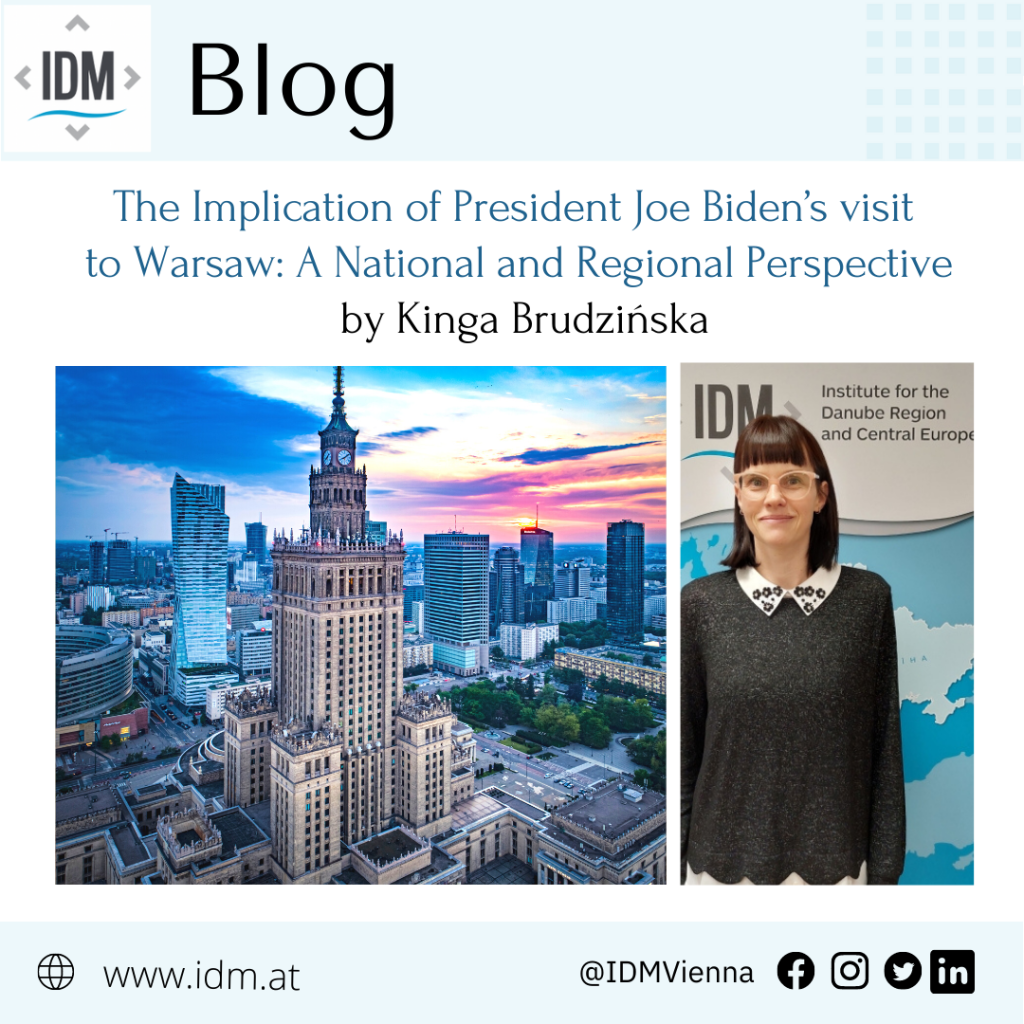
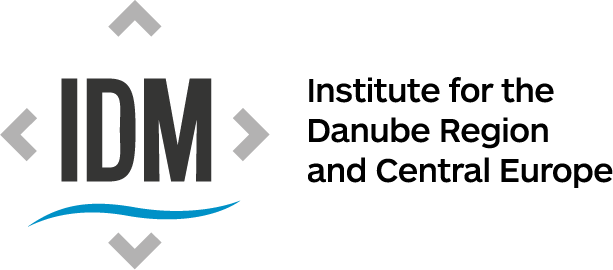
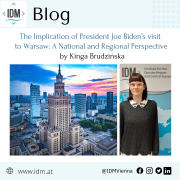
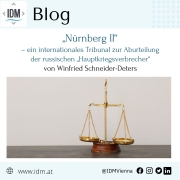

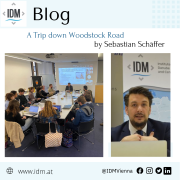

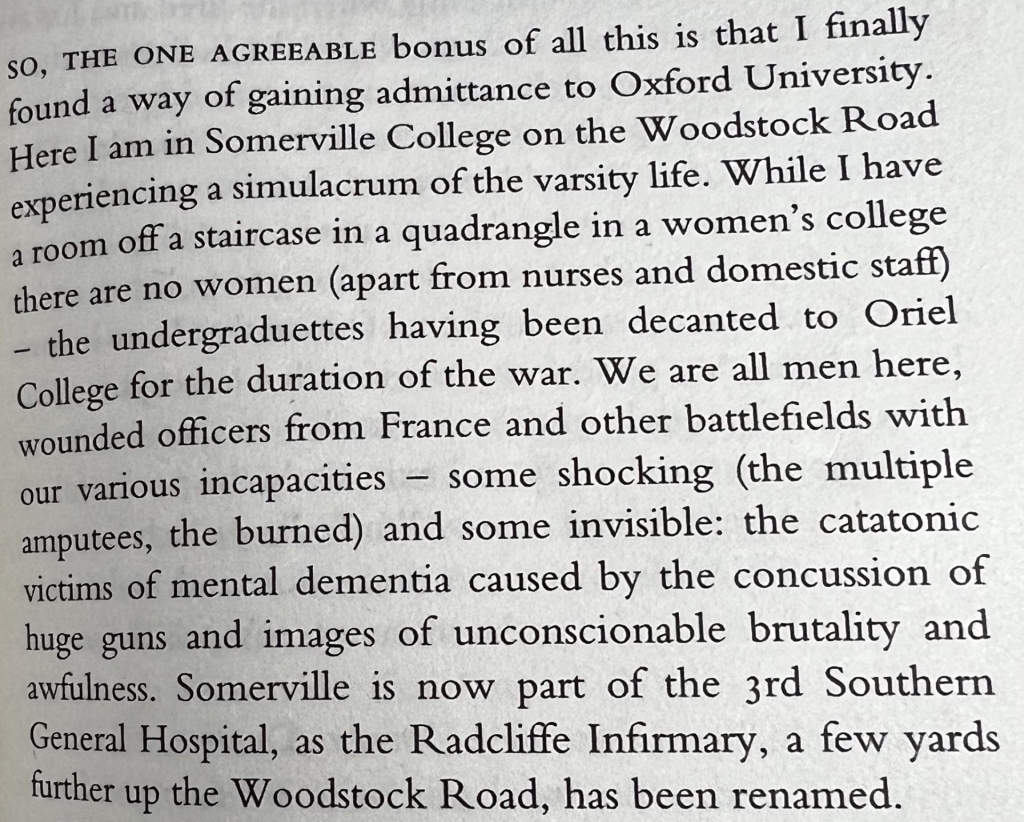
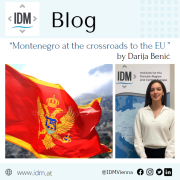

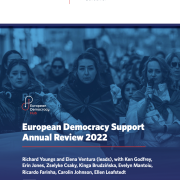
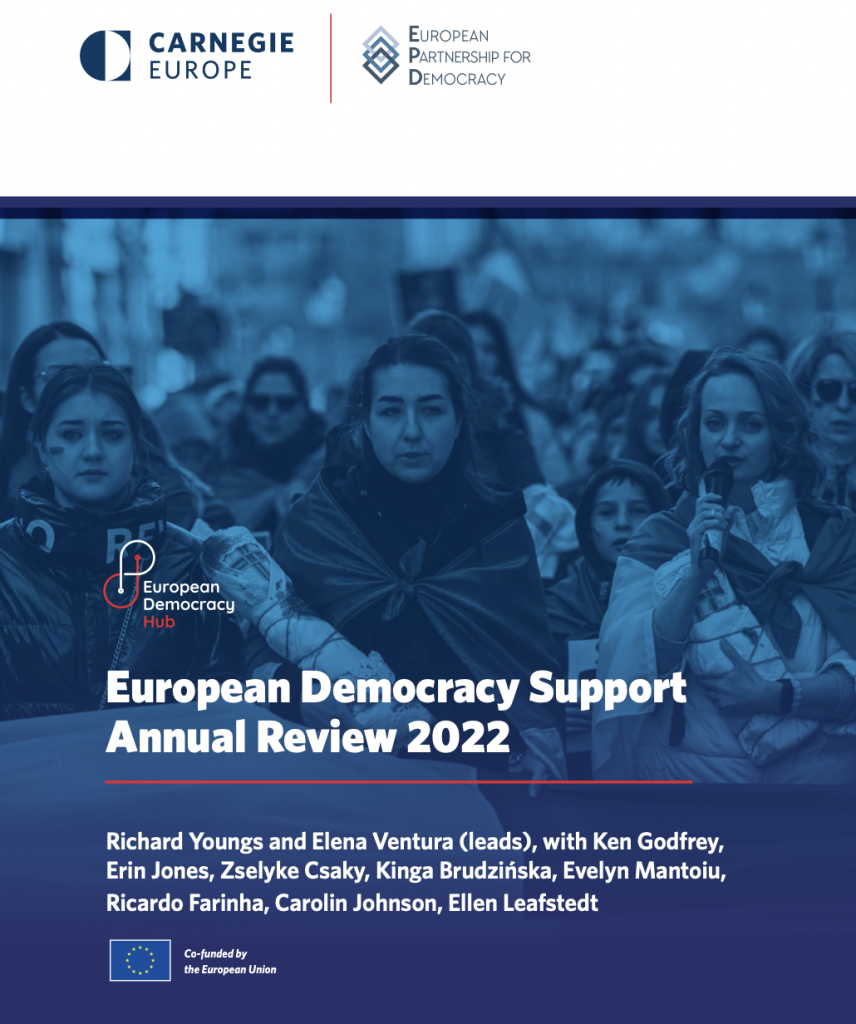
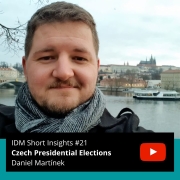
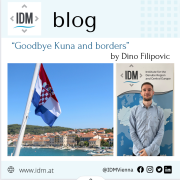
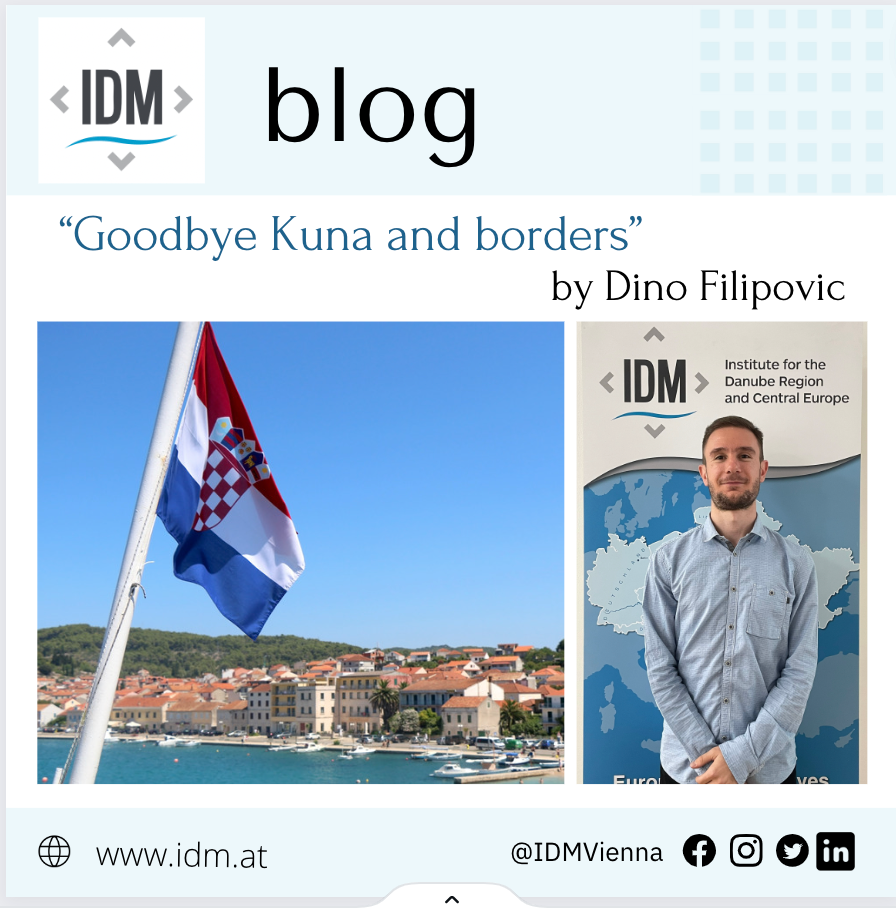 The celebration on New Year’s Eve took many of us away for a moment from the fact that last year brought us war and that many new challenges await us in the next one. Few could have predicted that in the year 2022, on European soil, we would witness the insane destruction of cities and the misfortunes of many people. However, we can only hope that these tectonic changes in international relations will have as few adverse effects on our lives as possible and that the new year 2023 will be much more positive. In this direction, the war experiences of the 1990s in Croatia can be an example to the Ukrainian people that even such difficulties will eventually be overcome and that a period of reconstruction and prosperity will soon follow.
The celebration on New Year’s Eve took many of us away for a moment from the fact that last year brought us war and that many new challenges await us in the next one. Few could have predicted that in the year 2022, on European soil, we would witness the insane destruction of cities and the misfortunes of many people. However, we can only hope that these tectonic changes in international relations will have as few adverse effects on our lives as possible and that the new year 2023 will be much more positive. In this direction, the war experiences of the 1990s in Croatia can be an example to the Ukrainian people that even such difficulties will eventually be overcome and that a period of reconstruction and prosperity will soon follow.